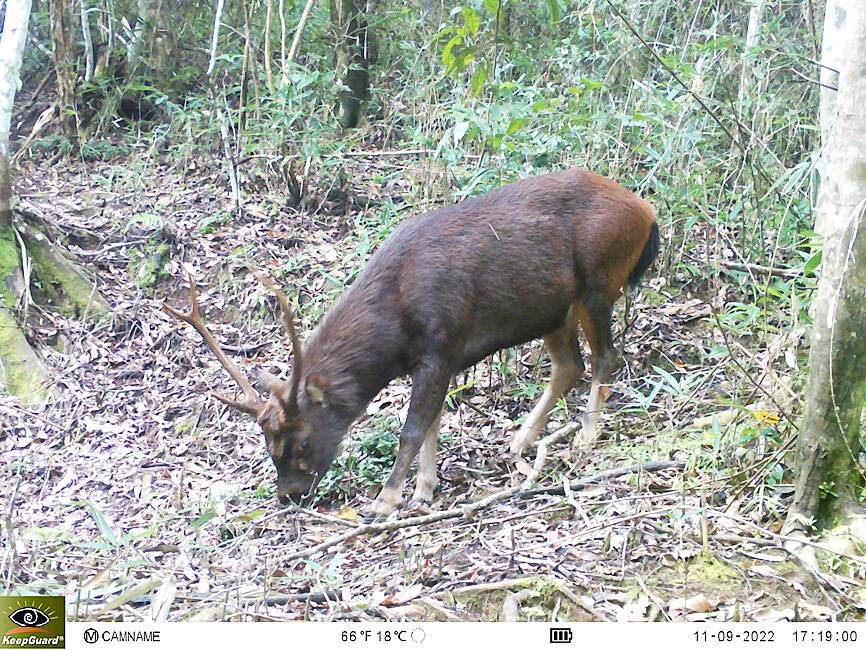Efforts to restore wildlife populations are bearing fruit, with photographs taken from trail cameras confirming the presence of Formosan sambar deer at lower altitudes at Taroko National Park in eastern Taiwan.
National Park Service officials provided the photographs following the completion of a two-year ecological monitoring program led by Weng Guo-jing (翁國精), head of National Pingtung University of Science and Technology’s Institute of Wildlife Conservation.
One of the photographs shows a Formosan sambar deer foraging for food on a mountain slope 661m above sea level, a report by Weng’s research team said.

Photo courtesy of Taroko National Park Headquarters
It was the first time in 15 years that a Formosan sambar deer was sighted at such a medium-to-low altitude, it said.
Researchers visited the site and verified, through an analysis of animal droppings, that the deer had been in the area.
A native species of Taiwan, the Formosan sambar deer is protected by conservation laws. The animals used to be found in mountain forests at altitudes of 300m to 3,500m. However, due to habitat destruction and poaching, their population declined sharply and their range of activity became limited.
In the past decade or so, they have only been seen at altitudes of more than 2,000m, park officials said.
Even at that height, few people have encountered the deer, and most of those who have seen them are veteran hikers who gave the animal a new name — Taiwan’s “mountain’s deity beast,” they said.
The photographs indicate that the native deer species have expanded their range of activity to the eastern section of Taroko National Park, although their main habitat remains in high-altitude forests, the report said.
The ecological monitoring program covered 22km2 area — two abandoned mining sites Dacingshuei (大清水) and Hueide (匯德), at altitudes of 500m to 1,500m. The team set up six voice recorders and 30 trail cameras that do not interfere with wildlife activities and start recording or taking photographs when they detect animal movement.
The report also recorded the presence of other protected native wildlife, including Berdmore’s ground squirrel, red and white giant flying squirrel and Formosan giant flying squirrel.
At a wildlife protection reserve at Mount Cingshuei, there had been sightings of Pallas’ squirrels, Berdmore’s ground squirrels, and the two types of giant flying squirrels, as well as audio recordings of Formosan samba deer, it said.
Most wildlife in the park have become more active and chances of seeing them are higher from March to May and September to November, officials said.
Results from the monitoring program are to be used as a reference for the conservation and management of these animals, while the public can read the report online on Taroko National Park’s Web site, they said.

SHIPS, TRAINS AND AUTOMOBILES: The ministry has announced changes to varied transportation industries taking effect soon, with a number of effects for passengers Beginning next month, the post office is canceling signature upon delivery and written inquiry services for international registered small packets in accordance with the new policy of the Universal Postal Union, the Ministry of Transportation and Communications said yesterday. The new policy does not apply to packets that are to be delivered to China, the ministry said. Senders of international registered small packets would receive a NT$10 rebate on postage if the packets are sent from Jan. 1 to March 31, it added. The ministry said that three other policies are also scheduled to take effect next month. International cruise ship operators

NUMBERS IMBALANCE: More than 4 million Taiwanese have visited China this year, while only about half a million Chinese have visited here Beijing has yet to respond to Taiwan’s requests for negotiation over matters related to the recovery of cross-strait tourism, the Tourism Administration said yesterday. Taiwan’s tourism authority issued the statement after Chinese-language daily the China Times reported yesterday that the government’s policy of banning group tours to China does not stop Taiwanese from visiting the country. As of October, more than 4.2 million had traveled to China this year, exceeding last year. Beijing estimated the number of Taiwanese tourists in China could reach 4.5 million this year. By contrast, only 500,000 Chinese tourists are expected in Taiwan, the report said. The report

The Forestry and Nature Conservation Agency yesterday launched a gift box to market honey “certified by a Formosan black bear” in appreciation of a beekeeper’s amicable interaction with a honey-thieving bear. Beekeeper Chih Ming-chen (池明鎮) in January inspected his bee farm in Hualien County’s Jhuosi Township (卓溪) and found that more than 20 beehives had been destroyed and many hives were eaten, with bear droppings and paw prints near the destroyed hives, the agency said. Chih returned to the farm to move the remaining beehives away that evening when he encountered a Formosan black bear only 20m away, the agency said. The bear

HORROR STORIES: One victim recounted not realizing they had been stabbed and seeing people bleeding, while another recalled breaking down in tears after fleeing A man on Friday died after he tried to fight the knife-wielding suspect who went on a stabbing spree near two of Taipei’s busiest metro stations, Taipei Mayor Chiang Wan-an (蔣萬安) said. The 57-year-old man, identified by his family name, Yu (余), encountered the suspect at Exit M7 of Taipei Main Station and immediately tried to stop him, but was fatally wounded and later died, Chiang said, calling the incident “heartbreaking.” Yu’s family would receive at least NT$5 million (US$158,584) in compensation through the Taipei Rapid Transit Corp’s (TRTC) insurance coverage, he said after convening an emergency security response meeting yesterday morning. National